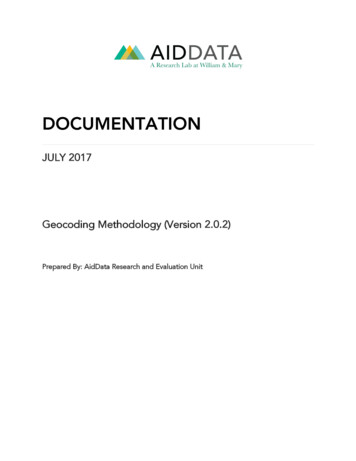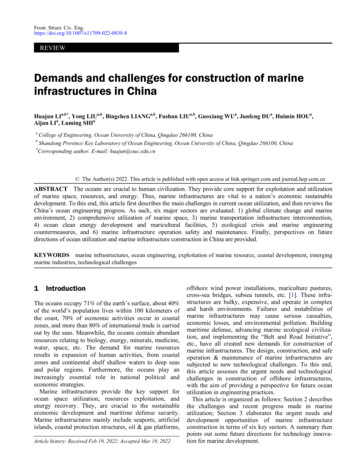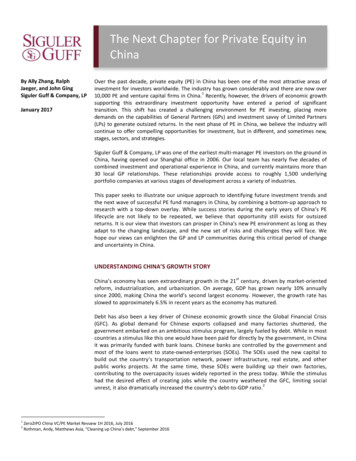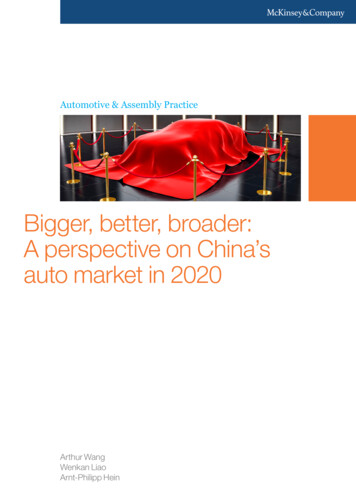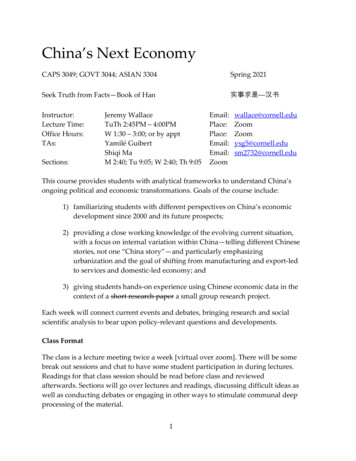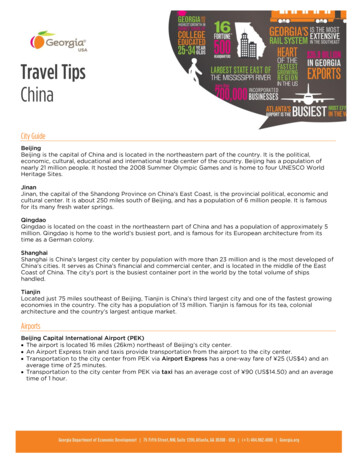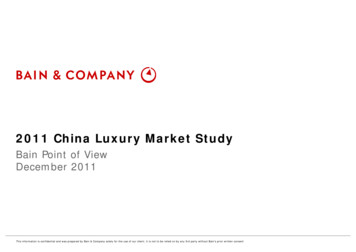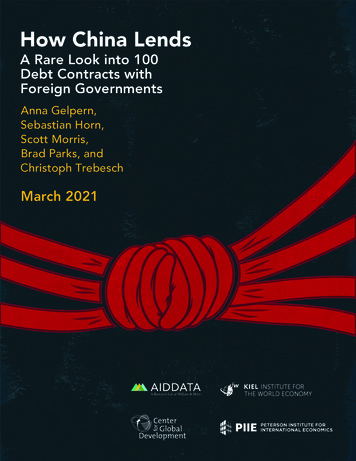
Transcription
[cover here]HowChina LendsA Rare Look into 100Debt Contracts withForeign GovernmentsAnna Gelpern,Sebastian Horn,Scott Morris,Brad Parks, andChristoph TrebeschMarch 20211
How China Lends:A Rare Look into 100 Debt Contracts with Foreign GovernmentsAnna GelpernGeorgetown Law and Peterson Institute for International Economicsag1348@georgetown.eduSebastian HornKiel Institute for the World Economysebastian.horn@ifw-kiel.deScott MorrisCenter for Global Developmentsmorris@cgdev.orgBrad ParksAidData, William and Mary, and Center for Global Developmentbparks@aiddata.orgChristoph TrebeschKiel Institute, Kiel University, and CEPRchristoph.trebesch@ifw-kiel.deAbstractChina is the world’s largest official creditor, but we lack basic facts about the terms and conditions of itslending. Very few contracts between Chinese lenders and their government borrowers have ever beenpublished or studied. This paper is the first systematic analysis of the legal terms of China’s foreignlending. We collect and analyze 100 contracts between Chinese state-owned entities and governmentborrowers in 24 developing countries in Africa, Asia, Eastern Europe, Latin America, and Oceania, andcompare them with those of other bilateral, multilateral, and commercial creditors. Three main insightsemerge. First, the Chinese contracts contain unusual confidentiality clauses that bar borrowers fromrevealing the terms or even the existence of the debt. Second, Chinese lenders seek advantage overother creditors, using collateral arrangements such as lender-controlled revenue accounts and promisesto keep the debt out of collective restructuring (“no Paris Club” clauses). Third, cancellation,acceleration, and stabilization clauses in Chinese contracts potentially allow the lenders to influencedebtors’ domestic and foreign policies. Even if these terms were unenforceable in court, the mix ofconfidentiality, seniority, and policy influence could limit the sovereign debtor’s crisis managementoptions and complicate debt renegotiation. Overall, the contracts use creative design to manage creditrisks and overcome enforcement hurdles, presenting China as a muscular and commercially-savvylender to the developing world.2
Acknowledgements: We thank Olivier Blanchard, Lee Buchheit, Guy-Uriel Charles, Mitu Gulati, PatrickHonohan, Nicholas Lardy, Adnan Mazarei, Carmen M. Reinhart, Arvind Subramanian, Edwin M. Truman,Jeromin Zettelmeyer, two anonymous reviewers, and the participants in a March 2021 workshop at thePeterson Institute for International Economics (PIIE) for comments on an earlier version of this paper.We thank Eva Zhang from the Peterson Institute for International Economics for reviewing our data andreplicating our analysis, as well as John Custer, Parker Kim, and Soren Patterson from AidData for copyediting, formatting, and graphic design of the final publication. We also owe a debt of gratitude to thelarge team of research assistants (RAs)—including Aiden Daly, Alex McElya, Amelia Grossman, AndrewBrennan, Andrew Tanner, Anna East, Arushi Aggarwal, Bat-Enkh Baatarkhuu, Beneva DaviesNyandebo, Carina Bilger, Carlos Hoden-Villars, Caroline Duckworth, Caroline Morin, Catherine Pompevan Meerdervoort, Cathy Zhao, Celeste Campos, Chifang Yao, Christian Moore, Claire Schlick, ClaireWyszynski, Connor Sughrue, Dan Vinton, David (Joey) Lindsay, Eileen Dinn, Elizabeth Fix, ElizabethPokol, Emma Codd, Emmi Burke, Erica Stephan, Fathia Dawodu, Florence Noorinejad, GabrielleRamirez, Georgiana Reece, Grace Klopp, Haley VanOverbeck, Han (Harry) Lin, Hannah Slevin, Harin Ok,Isabel Ahlers, Jack Mackey, Jiaxin Tang, Jiaying Chen, Jim Lambert, Jingyang Wang, Jinyang Liu, JohnJessen, Johnny Willing, Jordan Metoyer, Julia Tan, Julian Allison, Lukas Franz, Kacie Leidwinger,Kathryn Yang, Kathryn Ziccarelli, Kathrynn Weilacher, Kieffer Gilman Strickland, Kiran Rachamallu, LeslieDavis, Linda Ma, Lydia Vlasto, Marty Kibiswa, Mary Trotto, Mattis Boes, Maya Priestley, Mengting Lei,Mihika Singh, Molly Charles, Natalie Larsen, Natalie White, Olivia Le Menestrel, Olivia Yang, PaigeGroome, Paige Jacobson, Patrick Loeffler, Pooja Tanjore, Qier Tan, Raul De La Guardia, RichardRobles, Rodrigo Arias, Rory Fedorochko, Ryan Harper, Sam LeBlanc, Samantha Rofman, Sania Shahid,Sarah Farney, Sariah Harmer, Sasan Faraj, Sebastian Ruiz, Shannon Dutchie, Shishuo Liu, Sihan(Brigham)Yang, Solange Umuhoza, Steven Pressendo, Taige Wang, Tasneem Tamanna Amin, Thai-BinhElston, Undra Tsend, Victoria Haver, Wassim Mukayed, Wenyang Pan, Wenye Qiu, Wenzhi Pan,Williams Perez-Merida, Xiangdi William Wu, Xiaofan Han, Xinxin (Cynthia) Geng, Xinyao Wang, XinyuePang, Xuejia (Stella) Tong, Xufeng Liu, Yannira Lopez Perez, Yian Zhou, Yiling (Elaine) Zhang, YiwenSun, Youjin Lee, Yunhong Bao, Yunji Shi, Yunjie Zhang, Yuxin (Susan) Shang, Zihui Tian, Ziqi Zheng, Ziyi(Zoey) Jin, and Ziyi Fu—who helped identify, retrieve, and code the loan contracts in this study. We alsoreceived excellent project and data management support from Brooke Russell, Joyce Jiahui Lin,Katherine Walsh, Kyra Solomon, Lincoln Zaleski, Mengfan Cheng, Sheng Zhang, and Siddhartha Ghose.This study was made possible with generous financial support from the William and Flora HewlettFoundation, the Ford Foundation, the Bill & Melinda Gates Foundation, the UK Foreign,Commonwealth & Development Office (FCDO), and Georgetown University Law Center. We alsoacknowledge that it was indirectly made possible through a cooperative agreement (AID-OAA-A-1200096) between USAID’s Global Development Lab and AidData at the College of William and Maryunder the Higher Education Solutions Network (HESN) Program. Sebastian Horn and ChristophTrebesch gratefully acknowledge support from the German Research Foundation (DFG) under thePriority Programme SPP 1859. The views expressed here do not necessarily reflect the views of theWilliam and Flora Hewlett Foundation, the Ford Foundation, USAID, FCDO, the United StatesGovernment, or the Government of the United Kingdom.3
SECTION 1IntroductionThe Chinese government and its state-owned banks have lent record amounts to governments in lowand middle-income countries since the early 2000s, making China the world’s largest official creditor.Although several recent studies examine the economics of Chinese lending, we still lack basic factsabout how China and its state-owned entities lend—in particular, how the loan contracts are writtenand what terms and conditions they contain.1 Neither Chinese creditors nor their sovereign debtorsnormally disclose the text of their loan agreements. But the legal and financial details in theseagreements have gained relevance in the wake of the Covid-19 shock and the growing risks of financialdistress in countries heavily indebted to Chinese lenders.2 In light of the high stakes, the terms andconditions of China’s debt contracts have become a matter of global public interest.China’s loan agreements—sight unseen—are the subject of intense debate and controversy. Somehave suggested that Beijing is deliberately pursuing “debt trap diplomacy,” imposing harsh terms onits government counterparties and writing contracts that allow it to seize strategic assets when debtorcountries run into financial problems (e.g., Chellaney 2017; Moody’s 2018; Parker and Chefitz 2018).Senior U.S. government officials have argued that Beijing “encourages dependency using opaquecontracts [ ] that mire nations in debt and undercut their sovereignty” (Tillerson 2018). At the oppositeend of the spectrum, others have emphasized the benefits of China’s lending and suggested thatconcerns about harsh terms and a loss of sovereignty are greatly exaggerated (e.g., Bräutigam 2019;Bräutigam and Kidane 2020; Jones and Hameiri 2020).This debate in large part is based on conjecture. Neither policymakers nor scholars know if Chineseloan contracts would help or hobble borrowers, because few independent observers have seen them.Existing research and policy debate rests upon anecdotal accounts in media reports, cherry-pickedcases, and isolated excerpts from a small number of contracts. Our paper seeks to address this gap inthe literature.We present the first systematic analysis of China’s foreign lending terms by examining 100 debtcontracts between Chinese state-owned entities and government borrowers in 24 countries around theworld, with commitment amounts totaling 36.6 billion. All of these contracts were signed between2000 and 2020. In 84 cases, the lender is the Export-Import Bank of China (China Eximbank) or ChinaDevelopment Bank (CDB). Many of the contracts contain or refer to borrowers’ promises not to disclosetheir terms—or, in some cases, even the fact of the contract’s existence. We were able to obtain thesedocuments thanks to a multi-year data collection initiative undertaken by AidData, a research lab atWilliam and Mary. AidData’s team of faculty, staff, and research assistants identified and collectedelectronic copies of 100 Chinese loan contracts (not summaries or excerpts of these contracts) byconducting a systematic review of public sources, including debt information management systems,1Acker et al. (2020), Dreher et al. (2021), Horn et al. (2019), Hurley et al. (2018) and Kratz et al. (2019) collect data andexamine the economic and financial aspects of Chinese foreign lending and debt restructuring activities in detail, but generallyavoid engaging with non-financial (legal) terms in the debt contracts.2As of January 2021, according to the IMF, about half of all low-income countries were in debt distress or faced a high risk ofentering distress. Since the start of the Covid-19 crisis, the G20 has agreed on a debt service suspension initiative (DSSI) forpoor indebted countries as well as on a Common Framework for Debt Treatments beyond DSSI.4
official registers and gazettes, and parliamentary websites.3 In partnership with AidData, we havedigitized and published each of these contracts in a searchable online repository (seehttps://www.aiddata.org/how-china-lends).4Our sample of 100 contracts with Chinese creditors represents a small part of the more than 2000 loanagreements that China’s state-owned lenders have signed with developing countries since the early2000s (Horn et al. 2019). However, it is sufficiently large to make clear that Chinese entities usestandardized contracts, and to identify a handful of prevalent contract forms, which appear to vary bylender. Each Chinese entity in our sample uses its own contract form across all of its foreign borrowers.Three main forms, or contract types, occur most often in our sample: the CDB loan contract, the ChinaEximbank concessional loan contract, and the China Eximbank non-concessional loan contract (seeAppendix II for our typology). We find substantial overlap in how these entities write debt contractswith foreign governments, which suggests that our sample is informative of the larger universe of otherCDB and China Eximbank contracts.We have analyzed the full text of every contract document we could find. We are not aware of anyanalysis of sovereign debt contracts with Chinese lenders that uses more than a handful of contracts orcontract excerpts. Having access to the entire universe of sovereign debt contracts, including but notlimited to those with Chinese lenders, would be preferable—but most of these contracts are shroudedin secrecy. Until disclosure becomes the norm, being able to evaluate and compare 100 contract textsis a significant step forward.We start by coding the terms and conditions of the 100 Chinese debt contracts we found. In additionto the key financial characteristics of each contract (principal, interest, currency, maturity, amortizationschedule, collateral, and guarantees), we code key non-financial terms that have played important rolesin contemporary sovereign debt contract practice. These include priority (status), events of default andtheir consequences (including cross-default and acceleration), termination and cancellation,enforcement (including waiver of immunity and governing law), and confidentiality.We then endeavor to evaluate China’s contracts in a broader international sovereign debt contractingcontext. For this purpose, alongside the contracts with Chinese lenders, we code a benchmark set offoreign debt contracts that consists of 142 loans from 28 commercial, bilateral, and multilateralcreditors. With few exceptions, neither sovereign debtors nor their creditors normally publish theircontract texts in full. Our benchmark contracts are from Cameroon, the only developing country that, atthe time of our study, had published all of its project-related loan contracts with foreign creditors of alltypes, entered into between 1999 and 2017. We compare the Chinese contract terms with those in thebenchmark sample, as well as the model commercial loan contract published by the London-basedLoan Market Association (hereinafter “the LMA template”).The summary results of our analysis are as follows. First, China’s state-owned entities blend standardcommercial and official lending terms, and introduce novel ones, to maximize commercial leverage3All of the loan agreements were obtained from publicly available sources. None of the agreements were obtained fromparties to the relevant contracts, advisers or agents of such parties or any other source that was subject to a confidentialityundertaking in respect of such documents. Some of these agreements were first published by investigative journalists and civilsociety organizations.4The contracts are searchable by lender, borrower, sector, and contract clause.5
over the sovereign borrower and to secure repayment priority over other creditors. The followingexamples illustrate: All of the post-2014 contracts with Chinese state-owned entities in our sample contain orreference far-reaching confidentiality clauses.5 Most of these commit the debtor not to discloseany of the contract terms or related information unless required by law.6 Only 2 of the 142contracts in the benchmark sample contain potentially comparable confidentiality clauses.Commercial debt contracts, including the LMA template, impose confidentiality obligationsprimarily on the lenders. Borrower confidentiality obligations outside the Chinese sample arerare and narrowly drawn. Broad borrower confidentiality undertakings make it hard for allstakeholders, including other creditors, to ascertain the true financial position of the sovereignborrower, to detect preferential payments, and to design crisis response policies. Mostimportantly, citizens in lending and borrowing countries alike cannot hold their governmentsaccountable for secret debts. 30 percent of Chinese contracts in our sample (representing 55 percent of loan commitmentamounts) require the sovereign borrower to maintain a special bank account—usually with abank “acceptable to the lender”—that effectively serves as security for debt repayment. Bankstypically have the legal and practical ability to offset account holders’ debts against accountbalances. These set-off rights can function as cash collateral without the transparency of aformal pledge. Contracts in our sample require borrowers to fund special accounts withrevenues from projects financed by the Chinese lender, or with cash flows that are entirelyunrelated to such projects. In practice, this means that government revenues remain outside theborrowing country and beyond the sovereign borrower’s control. Offshore accounts arecommon in limited-recourse project finance transactions, but they are highly unusual incontemporary, full-recourse sovereign lending.7 In our benchmark sample, we find only threeanalogous arrangements: one each with a multilateral, a bilateral, and a commercial lender. TheU.S. emergency loan to Mexico in 1995, which required oil revenues to flow through an accountat the Federal Reserve Bank of New York, is a high-profile exception that proves the rule. Oneneeds to go back to the 19th and early 20th century to find similar security arrangements insovereign lending on the scale that we observe in our Chinese contract sample (Borchard andHotchkiss 1951; Wynne 1951; Maurer 2013). When combined with confidentiality clauses,revenue accounts pose significant challenges for policymaking and multilateral surveillance. If asubstantial share of a country’s revenues is under the effective control of a single creditor,conventional measures of debt sustainability are likely to overestimate the country’s true debtservicing capacity and underestimate its risk of debt distress. Close to three-quarters of the debt contracts in the Chinese sample contain what we term “NoParis Club” clauses, which expressly commit the borrower to exclude the debt fromrestructuring in the Paris Club of official bilateral creditors, and from any comparable debt5We were not able to obtain separate borrower confidentiality letters referenced in some of the contracts.6At least one contract specifically bars disclosure of English governing law and international arbitration provisions.7When a project is financed with a non-recourse or limited-recourse structure, the loan that is used to finance the acquisition,construction, and maintenance of an asset (e.g., a toll road) is repaid from the cash flow generated by the asset (e.g., tollrevenue). The lender’s claim is typically against a special-purpose project company rather than the recipient countrygovernment, and depends primarily on the financial viability of the project.6
treatment. These provisions predate and stand in tension with commitments China’sgovernment has made under the G20 Common Framework for Debt Treatments beyond theDSSI (the “Common Framework”), announced in November 2020. The framework commits G20governments to coordinate their debt relief terms for eligible countries. All contracts with China Eximbank and CDB include versions of the cross-default clause,standard in commercial debt, which entitles the lender to terminate and demand immediate fullrepayment (acceleration) when the borrower defaults on its other lenders. Some contracts in oursample, discussed in more detail below, also cross-default to any action adverse to China’sinvestment interests in the borrowing country. Every commercial contract in our benchmarksample includes a cross-default clause, as does the LMA template. Only around half of allbilateral official debt contracts, and just 10 percent of multilateral debt contracts in thebenchmark sample contain cross-default clauses. Instead, multilateral debt contracts usually letthe lender suspend or cancel the contract if the debtor fails to perform its obligations underdifferent contracts with the same lender, or in connection with the same project. Both crossdefault and cross-suspension clauses put pressure on the debtor to perform or renegotiate, butthey serve somewhat different purposes. A commercial cross-default clause helps protectcreditors from falling behind in the payment queue; a cross-suspension clause lets a policylender pause disbursements when the debtor’s policy or project effort—or its relationship withthe lending institution—deteriorates. Some Chinese contracts combine elements of both,further constraining the sovereign borrower.Second, several contracts with Chinese lenders contain novel terms, and many adapt standardcommercial terms in ways that can go beyond maximizing commercial advantage. Such terms canamplify the lender’s influence over the debtor’s economic and foreign policies. For instance, 50 percent of CDB contracts in our sample include cross-default clauses that can be triggeredby actions ranging from expropriation to actions broadly defined by the sovereign debtor asadverse to the interests of “a PRC entity.” These terms seem designed to protect a wide swathof Chinese direct investment and other dealings inside the borrowing country, with no apparentconnection to the underlying CDB credits. They are especially counterintuitive in light of China’scharacterization of CDB as a “commercial” lender. No contract in our benchmark samplecontains similar terms. All CDB contracts in our sample include the termination of diplomatic relations between Chinaand the borrowing country among the events of default, which entitle the lender to demandimmediate repayment. More than 90 percent of the Chinese contracts we examined, including all CDB contracts, haveclauses that allow the creditor to terminate the contract and demand immediate repayment incase of significant law or policy changes in the debtor or creditor country. 30 percent of Chinesecontracts also contain stabilization clauses, common to non-recourse project finance, wherebythe sovereign debtor assumes all the costs of change in its environmental and labor policies.Change-of-policy clauses are standard in commercial contracts, including the LMA template,but they take on a different meaning when the lender is a state entity that may have a voice inthe policy change, rather than a private firm on the receiving end of new financial regulations orUN sanctions. At the extreme, policy change clauses could allow the state lender to accelerate7
loan repayment and set off a cascade of defaults in response to political disagreements with theborrowing government.Overall, the contracts in our sample suggest that China is a muscular and commercially-savvy lender todeveloping countries. Chinese contracts contain more elaborate repayment safeguards than their peersin the official credit market, alongside elements that give Chinese lenders an advantage over othercreditors. At the same time, many of the terms and conditions we have reviewed exhibit a difference indegree, not in kind, from commercial and other official bilateral lenders. All creditors, includingcommercial banks, hedge funds, suppliers, and export credit agencies, seek a measure of influenceover debtors to maximize their prospects of repayment by any legal, economic, and political meansavailable to them (e.g., Gelpern 2004; Gelpern 2007; Schumacher et al. 2021). However, China’scontracts also contain unique provisions, such as broad borrower confidentiality undertakings, thepromise to exclude Chinese lenders from Paris Club and other collective restructuring initiatives, andexpansive cross-defaults designed to bolster China’s position in the borrowing country. Our analysisalso calls attention to terms that might be unremarkable in a commercial debt contract, such as thepolicy change event of default, which could acquire a different meaning and new potency ingovernment-to-government lending arrangements.It bears emphasis that our study does not systematically address contract implementation andenforcement, for which there is limited anecdotal evidence. It is entirely possible that some of thecontract features we identify serve an expressive purpose, or function in terrorem, to dissuade thedebtor from taking steps adverse to the creditor’s interests. Several of the unusual terms we identify,including the promise to forswear restructuring, would likely be unenforceable in court in a majorfinancial jurisdiction. Because most of the contracts in our sample specify Chinese governing law andarbitration in China, we cannot predict how the terms in question would fare in a dispute. Any givenlender might prefer to avoid adjudication or arbitration altogether. Nonetheless, promises thateventually turn out to be unenforceable could be a source of formal and informal pressure on thedebtor, especially if the creditor invokes their breach to block a special revenue account it controls.The enforcement terms themselves—choice of law, forum selection, and waivers of sovereignimmunity—have attracted attention in policy and research circles (e.g., Bräutigam et al. 2020), but lookmostly unremarkable to us. Like other bilateral creditors in the benchmark sample, China Eximbankinsists on its domestic governing law and a dispute resolution forum in its home country. While ChinaEximbank contracts usually specify arbitration before the China International Economic and TradeArbitration Commission (CIETAC) and using its procedures, both commercial and bilateral officialcreditors that agree to submit their disputes to arbitration choose the procedural rules of the Londonbased International Chamber of Commerce (ICC). CDB follows commercial practice in this area: sevenout of eight CDB contracts in our sample are governed by English Law; one is governed by New YorkLaw; they specify different arbitration venues and ICC rules. Sovereign immunity waivers in the Chinesesample contracts are generally in line with the LMA template and the commercial contracts in ourbenchmark set. In sum, despite their media prominence, the enforcement terms in China’s contractsappear to be broadly consistent with the practices of other lenders. We are not in a position to evaluatethe substance of Chinese law or China’s commercial dispute resolution regime in this study; nor do weopine on the merits of customary international practice. We simply note that the choice of creditors’domestic law to govern a debt contract appears to come with the territory.8
Our findings, while based on a limited sample of contracts, have significant implications for sovereigndebt contracting, sovereign debt policy, and the academic literature on sovereign debt.Lending to sovereign governments occurs in an environment of limited and indirect enforcement, withincomplete and uneven contract standardization and no statutory or treaty bankruptcy to supplygenerally accepted default outcomes. As a result, even when we find troubling terms in debt contractsbetween sovereign borrowers and China’s state-owned entities, we cannot conclude that they violateinternational standards: with few exceptions, such standards do not exist. On the other hand, wesuspect that the contracts we have examined are both more common than had been understood and asign of things to come. New and hybrid lenders that mix official and commercial institutional featuresare growing in importance for sovereign financing. These are not limited to China. We expect suchlenders to adapt and innovate contract features to maximize their commercial and political advantagein an increasingly crowded field.In the immediate future, our analysis should help inform the ongoing discussions on how to address therisk of debt distress across developing countries (e.g., IMF and World Bank 2020), including via globalinitiatives such as the Common Framework (Group of 20 2020). China’s distinct approach to lendingand debt restructuring has already created tensions between China and traditional multilateral lenders,between China and the rest of the G20, and between China and private creditors in countries likeZambia.8Our main contribution to the academic literature on sovereign debt is to show how China has adaptedsovereign debt contracts to manage repayment risk under conditions of weak contract enforcement(Tirole 2003; Aguiar and Amador 2015). A longstanding puzzle in international macroeconomics is whyprivate investment and lending to developing countries is so limited (Lucas 1990). One explanation isthat investments in high-risk countries simply do not pay off in light of their weak institutions and theassociated expropriation risk (Alfaro et al. 2008), as well as the high likelihood of sovereign defaults(Reinhart et al. 2003).We show how Chinese state-owned banks use contract tools to manage these and other risks. Theyadapt legal and financial engineering tools—some new and others over a century old—to protect theirinvestments and climb the “seniority ladder,” potentially gaining repayment advantage over othercreditors. We thereby add to the literature on seniority in sovereign debt markets, which has yet toexamine the role of China and other new creditors (e.g., Bolton and Jeanne 2009; Chatterjee andEyigungor 2015; Schlegl, Trebesch, Wright 2019). We also contribute to a large body of researchstudying international agreements that are hard to enforce, such as trade agreements (e.g. Horn,Maggi, and Staiger 2010; Maggi and Staiger 2011). Lastly, our paper is unique for its focus on a hybridcontract form—debt contracts between governments and state-owned entities that meld commercialand official contracting practices and innovate on both. These types of hybrid contracts betweensovereign or quasi-sovereign entities of different countries have received little attention in theliterature, but merit study as a distinct and growing phenomenon.The paper begins by introducing a new dataset of 100 sovereign debt contracts with Chinese stateowned lenders and a benchmark sample of 142 sovereign debt contracts between Cameroon and a8For recent reporting on tensions with private creditors and tensions with the World Bank and G20, see Bavier and Strohecker(2021) and Lawder (2020).9
broad range of bilateral, multilateral, and commercial creditors. We then describe the methods we useto evaluate the terms and conditions in these contracts and present the main insights by focusing onspecific provisions that set Chinese lenders apart from their peers and competitors from othercountries. We conclude with a discussion of policy considerations.10
SECTION 2Dataset and methodology: Coding the terms of 100 Chinese and142 benchmark debt contractsThis section introduces our new dataset of sovereign debt contracts. Section 2.1 focuses on the 100Chinese debt contracts, presents summary statistics, and discusses the extent to which the sample isrepresentative of the population of China’s official foreign lending activities. Section 2.2 presents keycharacteristics of the benchmark sample and discusses its similarities and differences with the Chinesecontract sample. In Section 2.3 we outline the methodology that we developed to code the terms ofChinese and benchmark contracts.2.1The Chinese contract sampleDespite its size and rapid growth, China’s foreign lending remains opaque. The Chinese gov
China is the world's largest official creditor, but we lack basic facts about the terms and conditions of its lending. Very few contracts between Chinese lenders and their government borrowers have ever been published or studied. This paper is the first systematic analysis of the legal terms of China's foreign lending.
